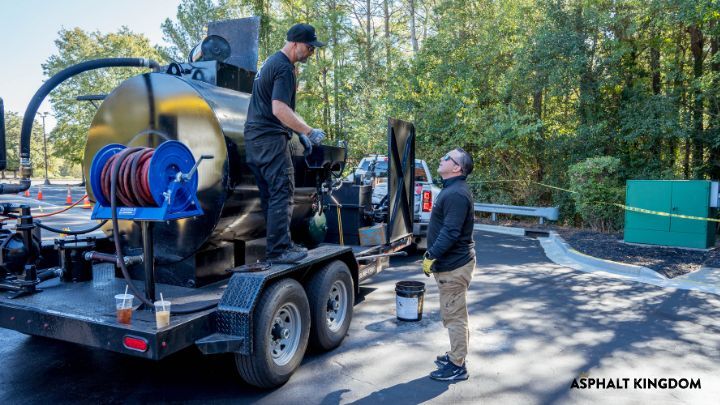What's in an Asphalt Pavement?
To better understand asphalt and how weather can impact it, let's discuss what's in an asphalt pavement first.
Asphalt pavements have two main components: aggregates and binder.
Let's take a look at aggregates first. Aggregates used in asphalt pavements are made up of crushed rocks, river gravel, minerals, and sand. They make up about 95% of the pavement and give asphalt roads, parking lots, and driveways their bulk and strength.
Keep in mind that the size of the aggregates in the mixture will vary depending on the type of pavement being constructed. For example, a busy thoroughfare will need larger aggregates, while a rural road that barely sees traffic will need smaller rocks and gravel.
The substance that binds all the aggregates together is asphalt. This black liquid, also known as bitumen, is sticky and goopy. The substance can be found in tar pits all over the world and has been used since ancient times for waterproofing and construction.
Did you know?
La Brea Pitch Lake is the largest tar pit in the world, measuring more than 400,000 square meters.
But tar pits and other natural sources of bitumen couldn't keep up with the demand as time passed. The solution? Scientists found a way to refine components of crude oil to produce what we now know as refined bitumen or simply, asphalt.
Weather: Asphalt's Greatest Enemy
There's no doubt that asphalt pavements can withstand regular wear and tear, as well as exposure to the elements. But despite their sheer strength and durability, asphalt pavements can deteriorate thanks to heavy vehicular traffic, vegetation, and chemicals (fuel, oil, and some deicers).
One of asphalt's greatest enemies, however, is the weather. So how does weather affect asphalt and contribute to its deterioration? Let's find out.
Extreme Heat
Asphalt parking lots and driveways typically last anywhere between 15 and 30 years, depending on how well they are maintained. But their lifespan can be significantly shortened when they are frequently exposed to extreme heat and the ultraviolet rays. Frequent exposure to extreme heat can cause the binder to lose strength, soften, and crack.
Related: When's the Best Time of Year to Sealcoat Driveway?
Extreme Cold
Extreme cold can make asphalt more rigid and brittle, but low temperatures alone cannot damage the pavement. What accelerates its deterioration is the presence of water in the form of snowmelt.
Let's say that it snowed during the day. The snow melts a few days later, and the resulting snowmelt seeps into the cracks in the pavement. Water fills these crevices, which then freezes when temperatures drop again.
All that frozen water expands the crevices in the asphalt, resulting in wider cracks and weakened foundation. As months or years pass, the pavement crumbles under the pressure of the freeze-thaw cycle. Once spring arrives, you'll see large cracks and potholes all over the asphalt.
How to Protect Your Asphalt Pavement from the Effects of Weather
Here are some ways to protect your pavement from rain, extreme heat, and snowmelt.
1. Fill cracks the moment you spot them
An ounce of prevention is better than a pound of cure, so it's best to fill cracks before they get bigger. When applied properly, crack filling works great in blocking snowmelt and rainwater from seeping into the crevices in the asphalt and damaging the pavement.
There are two ways you can fix asphalt cracks. First is by using liquid crack filler, and the other is by applying hot pour rubberized crack filler.
Which one should you use?
A liquid crack filler will suffice if the cracks in the asphalt are still small. This product is also ideal for use on residential driveways.
But if you own a commercial property, then call an asphalt contractor and have them fill cracks using hot pour rubberized crack filler. This type of crack filler is durable yet flexible and can withstand extreme temperatures.
Related: A Brief Guide on DIY Parking Lot Crack Repair
2. Patch those potholes
Potholes are not just simple eyesores; they can also be dangerous for parking lot users and costly for property owners. They can cause accidents and injuries to people unlucky enough to use the parking lot.
Patching potholes is not just done to preserve the beauty of your parking lot or safeguard your customers from injury. This is also a good way to protect your pavement asset from further damage because of rainwater and snowmelt. Patching acts like a cork that prevents water from entering the asphalt and prevents further deterioration.
3. Choose your deicing products carefully
When it comes to deicing products, there are so many options available for property owners. These include sodium chloride, urea, magnesium chloride, and calcium chloride, to name a few. But some of these deicing products can be damage asphalt pavements in the long run, so choose your ice melt carefully.
Your safest bets for melting ice on asphalt are sodium chloride and calcium chloride. Urea is also a good choice as it doesn't damage asphalt as much, but it's not as effective in melting ice compared to other deicing products.
Remember that excessive use of deicers (no matter what type of ice melt it is) can damage your asphalt, so use them when absolutely necessary. Also, do not use deicers when the asphalt already has extensive alligator cracking as they can damage the pavement further.
Looking for an effective deicer? Check out Asphalt Kingdom's Liquid Ice Melter and order it here.
4. Check your parking lot or driveway for pools of water
One of the most common causes of asphalt deterioration is water pooling in different areas of the parking lot or driveway. To prevent cracks and potholes from forming in your asphalt, always check for pools of water after it rains or when snow melts.
Related: 7 Critical Checks for Parking Lot Drains
5. Keep your asphalt snow-free
Protect your parking lot or driveway by using a snow shovel, snow plow, or snow blower. You can also use the Bensink Rotary Broom to get rid of snow on your driveway or parking lot.
6. Apply asphalt sealer
Think of asphalt sealer as your pavement's sunscreen. It protects the pavement from heat and oxidation, as well as blocks moisture from seeping into the tiny cracks. By sealing asphalt, you can extend your driveway or parking lot's normal lifespan.
Conclusion:
Now that you know about the impact of weather on asphalt pavements and how to protect your parking lot and driveway, it’s time to get into action. Order asphalt sealer, crack filler, and other asphalt repair and maintenance supplies from Asphalt Kingdom to get started.





-2.jpg)
-1.jpg)